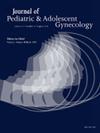23. 胶栓联合手术切除治疗出生时伴有泌尿生殖系统和会阴血管异常的儿童和青少年患者
IF 1.7
4区 医学
Q3 OBSTETRICS & GYNECOLOGY
引用次数: 0
摘要
血管异常(VA)包括广泛的肿瘤和毛细血管、动脉、静脉或淋巴管的畸形。VA通常在出生至儿童期被诊断出来,影响约5%的儿童,其中估计2-2.6%的儿童有泌尿生殖系统和会阴(GUP)受累,这可能导致疼痛、虚弱和审美问题。最近在VA手术管理的创新是n-BCA胶栓塞后手术切除。本研究回顾了这种联合手术方法治疗GUP-VA的技术成功和临床结果。病例:在这项经irb批准的回顾性图表回顾中,从1998年至2024年在一家三级保健儿童医院接受治疗的VA患者的大型数据库中确定了出生时患有GUP-VA的女性患者,这些患者接受了胶水栓塞和手术切除。我们回顾了人口统计学、手术程序和并发症以及之前和之后的治疗史。2014-2023年间,5例女性GUP-VA患者接受了胶栓塞和切除术(平均年龄13岁,范围3-22岁)。4例患者表现为先天性外阴动静脉畸形或静脉畸形,1例患者发生会阴体静脉畸形继发于马鞍损伤。治疗指征包括肿胀(100%)、疼痛(40%)和出血(20%)。2例患者既往接受过硬化治疗(n=1)和手术切除,最终症状复发(n=1)。用1:3或1:4的n-BCA胶在碘化油中进行栓塞。平均病灶大小为2.9 × 2.1 × 1.4 cm。3例患者在栓塞后立即切除,2例患者在第二天切除。手术在技术上100%成功:所有患者的症状都得到改善,没有一例VA复发。有1例非靶性胶水血栓栓塞到肺段性动脉;抽吸取栓术去除大部分胶血栓,患者氧合状态未见改变,肺动脉造影未见较大充盈缺损。手术过程简单;平均和中位手术失血量分别为46和50毫升。1例患者经历了伤口分离,并通过二次意图监测伤口愈合情况。平均随访时间为6个月,中位随访时间为3个月(范围1-14个月)。联合胶栓塞和切除是一种安全有效的治疗方案,适用于儿童和青少年的GUP-VA患者。本文章由计算机程序翻译,如有差异,请以英文原文为准。
23. Combined glue embolization and surgical excision for management of pediatric and adolescent patients assigned female at birth with genitourinary and perineal vascular anomalies
Background
Vascular anomalies (VA) encompass a broad range of tumors and malformations of the capillaries, arteries, veins or lymphatics. Often diagnosed in birth to childhood, VA affect around 5% of children, of whom an estimated 2-2.6% have genitourinary and perineal (GUP) involvement, which may contribute to pain, debility, and aesthetic concerns. A recent innovation in surgical management for VA is n-BCA glue embolization followed by surgical excision. This study reviews the technical success and clinical outcomes of this combined surgical approach for management of GUP-VA.
Case
For this IRB-approved retrospective chart review, patients assigned female at birth with GUP-VA who underwent glue embolization and surgical excision were identified from a large database of patients with VA who presented for care to a tertiary-care children's hospital from 1998-2024. Demographics, operative procedure and complications, and prior and subsequent treatment history were reviewed. Five female patients with GUP-VA underwent glue embolization and excision (mean age 13 years, range 3-22) between 2014-2023. Four patients presented with congenital vulvar arteriovenous or venous malformations, while one patient developed a perineal body venous malformation secondary to saddle injury. Indications for treatment included swelling (100%), pain (40%) and bleeding (20%). Two patients had undergone prior therapies, including sclerotherapy (n=1) and prior surgical excision with eventual symptom recurrence (n=1). Embolization was performed with 1:3 or 1:4 n-BCA glue in ethiodized oil. Mean lesion size was 2.9 × 2.1 × 1.4 cm. Three patients underwent excision immediately post-embolization, while two patients underwent excision the following day. The procedure was technically successful in 100% of patients: symptomatic improvement was achieved in all patients, and none experienced VA recurrence. There was one instance of nontarget glue thromboembolism to a segmental pulmonary artery; suction thrombectomy removed the majority of the glue thrombus without any change in patient's oxygenation status and no large filling defects on pulmonary arteriography. Excision procedures were uncomplicated; mean and median surgical blood loss volumes were 46 and 50 mL. One patient experienced wound separation and was monitored for wound healing by secondary intention. Mean and median follow-up duration were six and three months (range 1-14 months).
Comments
Combined glue embolization and excision is a safe and effective treatment option for pediatric and adolescent patients presenting with GUP-VA.
求助全文
通过发布文献求助,成功后即可免费获取论文全文。
去求助
来源期刊
CiteScore
3.90
自引率
11.10%
发文量
251
审稿时长
57 days
期刊介绍:
Journal of Pediatric and Adolescent Gynecology includes all aspects of clinical and basic science research in pediatric and adolescent gynecology. The Journal draws on expertise from a variety of disciplines including pediatrics, obstetrics and gynecology, reproduction and gynecology, reproductive and pediatric endocrinology, genetics, and molecular biology.
The Journal of Pediatric and Adolescent Gynecology features original studies, review articles, book and literature reviews, letters to the editor, and communications in brief. It is an essential resource for the libraries of OB/GYN specialists, as well as pediatricians and primary care physicians.

 求助内容:
求助内容: 应助结果提醒方式:
应助结果提醒方式:


